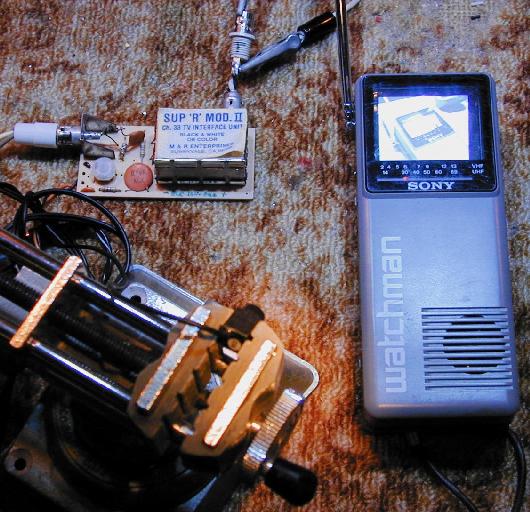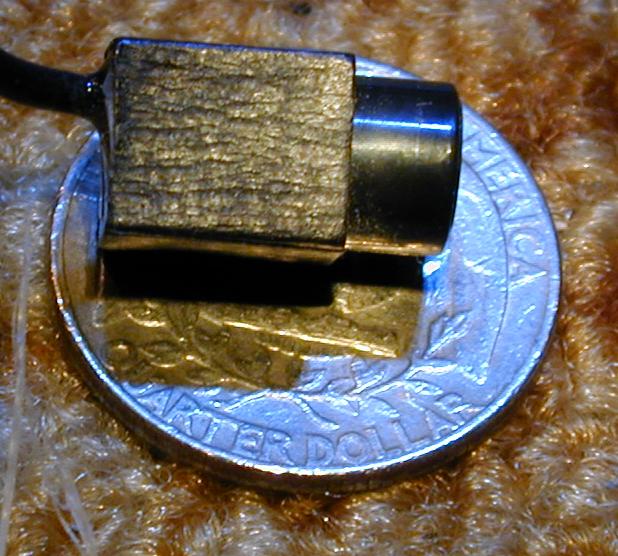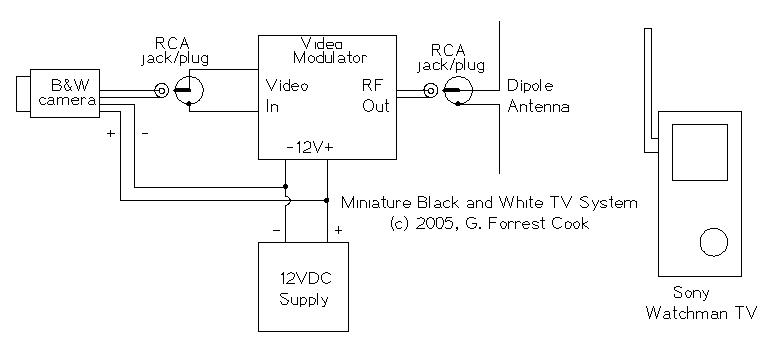
(C) 2005, G. Forrest Cook

Mini camera (in vise jaws), modulator and Sony Watchman

Close-up photo of a miniature B&W camera

Incredibly small NTSC closed-circuit video cameras are available for reasonable prices. Small televisions and video monitors are also available for low prices at online auction sites such as eBay. A video modulator provides a simple method for interfacing a camera's video signal to a standard TV with a VHF or UHF antenna input. This project shows how to build a miniature short-range wired or wireless video system using off-the-shelf parts. If this circuit is set up to have a wireless connection, the transmission distance will be limited to around ten feet or less.
Miniature cameras can be useful as a boroscope, a device for inspecting inside of holes, walls and other inaccessible spaces. A boroscope will require a companion White LED lamp. This circuit can be used to power two white LEDs and produce a regulated light level while running on the same 12VDC supply as many small cameras.
A 12VDC power supply provides power for the camera and video modulator circuits. A 6VDC power supply (or batteries) provide power to a Sony Watchman which is used as a video monitor. The video from the camera is fed into the video input of the modulator circuit. The modulated RF from the modulator is fed to either a direct connection on the television or into a small antenna. The modulated RF is picked up by TV receiver. A black and white image magically appears on the TV screen.
The camera's video signal is connected to the video modulator with an RCA jumper cable. A 12VDC power supply is connected to the camera and video modulator DC inputs. Be careful to observe the correct polarity on the power leads, reversing the wires will likely damage the modulator and possibly the camera. The camera that was used in this project has reverse polarity protection built in.
There are several ways to connect the video modulator output to the television receiver. The Sony Watchman does not have a video input, so a short jumper wire can be used to connect the center pin of the RF output jack to the Watchman antenna. This method produced the best image quality with the Watchman.
It is possible to send the modulator's RF output signal over the air via a small resonant dipole antenna, the antenna can be made with two short lengths of #16 gauge solid wire suspended in free air. A resonant antenna will help to extend the range of the TV signal. A good rule of thumb for the length of each wire measured in feet is: 234/F (Mhz). Channel 3 video is at 61.25 Mhz and channel 4 is at 67.25 Mhz, thus a channel 3 antenna should have wires cut to 3.8 feet or 3 feet and 9.6 inches. Since the modulator has very low power output, the signal will only travel a few feet before reception starts showing a lot of static. An external RF amplifier could be used to increase the range, but that is beyond the scope of this article.
If your monitor TV has an RF antenna input, it will be possible to feed the output of the modulator directly to the TV through a coax cable. The cable can be tens of feet long or more if remote viewing is desired. If the TV only has a flat-wire 300 ohm antenna input, use a 75 ohm to 300 ohm balun transformer between the coax and the TV. The balun will provide the best impedance match, this will give a clear video image with minimal distortion.
The camera, modulator and Watchman TV can be run on either battery power or from DC power supplies. The Watchman takes 6VDC and it does not have a power input jack, so the power will need to be connected via the battery terminals. It is possible to run the Watchman on 12VDC power if a 6V regulator IC such as an LM7806 is used ahead of the TV. A heat sink should be attached to the regulator IC to prevent over-heating. If you use a wall-wart DC power supply, be sure to verify the supply's output voltage with a meter before connecting it to any part of this setup. Wall-wart output voltages are often measured at a specific load current and can produce higher voltages than their labels indicate.
The PC-206XP camera used in this project is no longer available, Super Circuits carries a variety of color and black and white miniature cameras and other video accessories. Video modulators can be purchased from a variety of mail-order suppliers as well as eBay.
Apply power to the camera and modulator and turn on the TV. Tune the TV to the channel of the RF modulator, fine-tune the TV for the best picture. If your modulator has a video input level control, adjust the control for the best signal.
A fun use of this system would be to create an engineer's view of a model train layout. A loop of wire near the track would make a good receiving antenna. Power for the camera and modulator could be pulled from the engine motor circuit using a bridge rectifier feeding into an electrolytic capacitor, just make sure not to exceed the camera's 12V maximum supply voltage.
Back to FC's Video Circuits page.